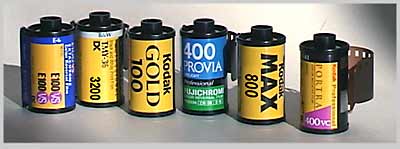Ask Ken:
Your source for expert advice.
Ken, Which film speed should I use?

PROBLEM # 2: Which film speed?
SOLUTION: an educated choice:
"Which film speed is best?" depends on what you want to shoot, and how you want to shoot it.
The short answer
is not the best, but the short answer is:
- 100 speed for stuff outdoors in the sunshine.
- 400 speed for indoors, or outdoors on cloudy days and action subjects.
- 200 speed if you can't make up your mind between 100 and 400.
This is about the limit of what you can buy at the grocery store. But this is pretty limiting. Did you know you can get film as slow as 6 and as fast as 6400? Did you know that you can take pictures at night with slow film?...without a flash?
Now for the long answer. Read through the whole list, and let's see if we can't open up whole new worlds of possibilities in your pictures.
- 50 speed and lower is great for pictures you want to enlarge to sizes like 16x20. I think every photographer should have at least one picture they have shot blown up big. Its a life-changing, wonderful experience. You will either need to shoot outdoors in sunshine, or use a flash, but its pretty cool. At the same time its unnecessary if you don't want big enlargements.
- 64 to 100 speed generally speaking has richer, smoother color, more detail and, all things being equal, looks "better" than the same image shot on faster film. You can use this outside in sunshine without any extra effort. It works great indoors or for night time stuff, but you will need a flash, or a tripod.
- 200 speed is either useless or perfect, depending on the photographer. Some feel it is too slow to use indoors or for nighttime stuff and yet not as good as slower film in daylight. Others feel it is the perfect compromise. But are compromised pictures what you want?
- 400 speed can be used in daylight just fine in most cases, but some lower end cameras will overexpose daylight shots with these films. It works well in lower light stuff such as indoors, or cloudy days without needing a flash or tripod. But of course if the light gets too low, you still need flash or tripod. Ten years ago 400 speed film was only good for 4x6 prints. It used to be too grainy for anything larger, but these days film is much improved over what it used to be. Most people are very satisfied with 8x10's from 400 speed film.
- 800 speed is good for low light and indoors where you can't use a flash or tripod, like indoor sporting events such as basketball or events on a stage, but the color isn't great(more on this another column). Its too fast for some cameras to use in daylight, and it doesn't tend to blow up well.
- 1000 speed is like 800 speed only more so. Great for indoor sporting events and stage shows. Also for weddings where a flash is disruptive. Generally too slow for outdoor nightime stadium events like football games.
- 1600 speed is good for serious low light stuff like nightime football games. Makes some pretty horrible blow ups. Color can be awful.
- 3200 speed is as fast as you can get over the counter. Not a pretty picture in terms of grain and detail. Some people like it for the artistic effect of it's harsh grain. Try a roll and see what you think. Don't even think about using this in sunshine.
- 6400 speed is specially processed black and white 3200 film. Used when nothing else matters but getting the picture. Will work in situations where other films won't record anything. Frequently used in surveilance situations.
- Variable speed films, like Kodak MAX films. The first issue of these films were horrible. Nobody liked it. But the MAX films have been revised and I personally haven't shot any of the second edition stuff, but it is supposed to be much better.
So what the heck, experiment a little. Buy a roll and see what you think.
Ken Casey;
Have a problem you would like to see addressed in this column? Send me an email at ken@caseycolor.com